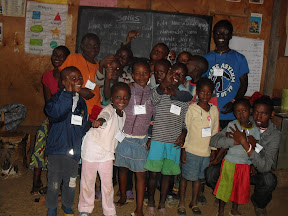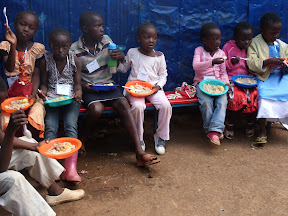In the month of April people think of Easter, springtime, eggs baskets and bunnies. But when I think of the month of april, none of that comes to mind. I will smile with my eyes closed. I will see children flooding a small corrugated metal room- full of noise and activity.
April is art camp!
April is planning, training, teaching.
April is acting, music, dancing, drawing, painting.
April is transformational creativity that flows through a child’s fingertips.
So of course I knew it was coming; the crazy preparations, collaborating with arts groups, networking, fundraising, etc. But all of these unseen things were well worth the energy when I see artists and children connecting with each other through art.

We began a two week marathon of art camps during an all day training, just two days before the actual camp was to begin. Since our first week of camp was in Kibera and the second week would shift to Kawangware, we required all artists from both areas to come for this day. Twenty-five artists learned about the buildabridge classroom model, divided into art class groups, wrote lesson plans, and for our grand finale – each group composed and sang songs about our theme, which is love.
On Thursday, April 19th, the artists met together in order to reflect and prepare for the day over a cup of chai, followed by our initial assembly where we divided the children into 5 classes; drama, dance, mural drawing, creative writing, and fashion, and introduced our theme of love. Because the Celtra arts group had taken responsibility to host this camp, I was out of the picture as far as coordinating the camp logistics. Once camp began, my focus was only on the mural drawing class.
In class I worked with two other teachers and about twenty children per class, on the first day (increasing every day). We have learned to adjust our teaching based on the money available for supplies, so instead of spending money on paints, we taught the children shading techniques using various gradients of pencil (HB, B2, B4). This involved much experimentation and shading exercises. The following day we discussed heroes in our live and how these figures have embodied love. Then we introduced people in the world who we would like to commemorate for their contributions and the ways they have shown love in their community. Mother Theresea and Wangari Mathai were the people we chose and then each child was given a small square that had been cut from a big picture of a portrait of one of those two people and then the kids would mimic the shadings that they saw on this small square, on a much bigger square paper. Once complete, I would take time that evening to adjust the shadings and drawings a bit to make sure that when all the squares were puzzled together; a complete portrait was formed. Before the celebration, the drawings would be laminated so that it was durable, and easy to display and dismantle. This five by five square mural was impressive and yet very cost effective!

On the day of our celebration, the children came in increasing numbers, including children from other organizations such as the Inspiration Center, which came to show support and perform during the presentations. In the afternoon each class stood up and proudly presented what they had been working on during the other days of camp. Finally certificates were given to all children who had attended all three days of camp and they proudly held onto those papers as we finished our up our camp for Kibera.
The following week was again packed with activity! On Monday we took the artist volunteers to a park for the day in order to appreciate their hard work and build team spirit among them. My hope has turned to assurance, that these artists are unified enough to continue the art camps in the years to come, and come together from various communities during different times of year.

The Thursday after our Kibera art camp, our same group of artists travelled to a church in the Kawangware community who had invited our artists to bring the camp to the children in their area. It was the church’s responsibility to recruit the children, identify the classroom spaces, negotiate the schedule of camp, hire cooks, and coordinate the celebration day. Our artists came in to just focus on the classroom teaching. In Kawangware our numbers grew to an even higher number of over 200 children, and the volunteers were over 30 since we had classroom artists who had gone through the training and then added more artists from the Kawangware community. Our second camp had similar structure to the first, and everyone was familiar with their role during camp, so that things ran pretty smoothly and again assured me that these events will be able to sustain themselves. On the final day we held a celebration in a big open area in Kawangware Slum, which attracted the attention of additional children and curious adults, as our children proudly showed off their new talents.
As I reflect on both camps this year, in addition to the four other camps that I have been involved in, I cannot help but compare and make a few observations of the bigger picture.
-
Initially, it is important to build a strong network and a team of artists from diverse communities surrounding Nairobi
-
It is important to have a hosting arts group which invites other artists to help, but one group that takes main responsibility to reach children in their community.
-
In time, quality artists will surface who are very knowledgeable in a specific art-form and who will take their teaching seriously.
-
Local and international support is important; however local is mainly in-kind donation while international mainly covers to financial donations.
-
After doing camps regularly, people are more familiar with them and thus more open to contribute
-
Communicating with sponsors and those who have donated is key.
-
Training must be mandatory
-
It is ok to feed the children lunch and focus more money on this than the art supplies because that does not
 necessarily have to subtract from the quality of teaching that the children receive.
necessarily have to subtract from the quality of teaching that the children receive.
-
The teachers must only take the responsibility of the classroom, while others should be assigned to plan and lead opening and closing assemblies.
necessarily have to subtract from the quality of teaching that the children receive.

Leave a comment